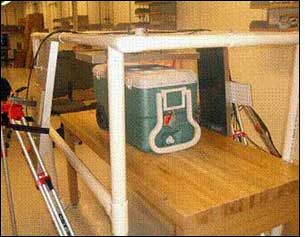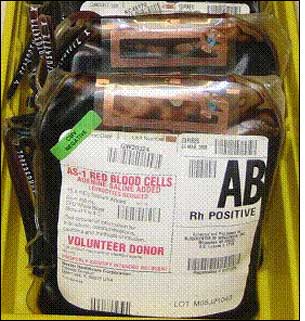Nov 04, 2009After completing a two-year study that determined high-frequency (HF) RFID technology would be safe to use and financially beneficial for blood banks, a group headed by the BloodCenter of Wisconsin (BCW) has received $1.4 million in funding from the National Institutes of Health (NIH) to begin building a prototype of an HF RFID solution. This solution would include software, tags, and handheld and tunnel readers that could be utilized by blood banks across the United States, as well as by hospitals that provide transfusions. The prototype development phase (slated to last two more years) will include further studies of any effect that RF transmissions might have on plasma—to follow up on a previous study of red blood cells and platelets—and complete an impact-analysis report related to the return on investment (ROI) for hospitals that might employ the system.
The first phase of the study, completed in February 2009, was undertaken by a collaboration of groups, including the University of Wisconsin (UW) RFID Lab, information services consulting firm SysLogic, Carter BloodCare, Mississippi Baptist Health System and the University of Iowa Hospitals & Clinics (see BloodCenter of Wisconsin to Study RFID's Effect on Blood).

This latest phase will be run by the same organizations. Mississippi Baptist Health System, Carter BloodCare and the University of Iowa Hospitals & Clinics will be used as models of different sizes and methods for managing blood products, as well as transfusions of those products.
The impact analysis of the first phase found that blood centers of BCW's approximate size, drawing blood for 250,000 transfusions annually, would typically recoup their expense of installing an RFID blood-tracking system within 3.9 years. This figure is based on an estimate that technology—including handheld or desktop readers, tags and software—would cost about $744,000 to acquire and install, and would provide a savings of $827,000 over a five-year period. Such savings would be the result of fewer man-hours spent tracking the movements of blood products, as well as a reduction in wastage resulting from blood products that had expired before they could be located and used. Another benefit—though harder to quantify—is the increased safety that would be created by better ensuring patients get the correct blood products, says Lynne Briggs, BCW's director of applications and project manager.
In Phase One, the Wisconsin group tested the effects of HF 13.56 MHz RF transmissions, compliant with the ISO 15693 standard, on red blood cells and platelets. During this phase, the blood products were subjected to between 23 and 25 consecutive hours of RF exposure at 13.56 MHz and five amperes/meter (100 watts). A simulated reader—using a loop device known as a Helmholtz coil to surround a blood bag—was utilized, rather than an actual RFID interrogator, thereby enabling researchers to bombard the blood bags with RF transmissions from all angles. The group chose to test only HF, Briggs explains, because ultrahigh-frequency UHF has the potential to excite the water molecules in the blood products to such level that they would be more likely than HF to raise the temperature.
"The FDA provided us with some good direction to help ensure what we did with RFID would be safe, and that we considered everything we should," Briggs states. This led to the initial tests on red blood cells and platelets. The group released the results to the FDA in spring 2008, and the agency reviewed those results. For the second phase, the FDA has requested a similar test for plasma before real products are used in a pilot, because it had not been part of the previous study of only red blood cells and platelets.

During Phase One, the UW RFID lab researchers also conducted feasibility tests to determine how well the tags could be read when attached to blood bags, and surrounded by the packing and storing materials typically used by blood centers.
The second phase includes building and then piloting the prototype. Although the location of that pilot has yet to be determined, Briggs says, the group has already decided at what points in the blood supply chain tags would be read, and which data would be stored on the tags, so that blood banks and hospitals could employ RFID technology to track the products from donor to recipient. Those permitted to read or write to the tag will be the tag manufacturer, the blood bag manufacturer, the blood center and the hospital transfusion service.
The HF ISO 15693 tags—the vendor for which has not yet been selected—will each come with a chip that has two separate sections allocated for data storage. The information stored on the tag must adhere to specifications outlined in a standard established by the International Society of Blood Transfusion (ISBT). The standard, known as ISBT Code 128, describes a system that uses Code 128 bar coding to identify and track the processing and use of human blood, tissue and cellular therapy products.
When a blood center draws blood, its staff will use a blood bag with an RFID tag attached with adhesive, then write the date and time onto the tag, along with the blood's type, donation identification number, and expiration date and time. The center will then process the blood, typically breaking it down to several containers of products, each with its own RFID tag, with data written to it detailing the product's origins. When a bag of processed blood leaves a blood center en route to a hospital, its tag will be read once more, in order to register that bag's departure, and the time and date of that activity will also be written to the tag. When the hospital receives the blood bag, it will utilize a separate section of the chip's memory to write such data as the receiving patient's medical record and date of birth, as well as the time and date. When the blood product is administered to the patient, the bag tag will be read again, thus confirming the patient is receiving the proper blood products. In some cases, if a transfusion is delayed, data indicating such a delay can be written to the tag, and the unused product bag can then be returned to the blood bank.
With the system's design already determined, Briggs says, the team needs only to select vendors for the hardware, and to create software to store data, which could then be shared by hospitals and blood banks. The technology will need to be generic, she says, meaning it must be able to integrate with any blood bank's existing blood establishment computer system (BECS). "The RFID software itself will not be that complicated," she indicates, "but it needs to be able to integrate with the BECS." The system is expected to be made available to blood centers and hospitals following the two-year research process, which includes piloting the technology.
Plasma is one of the more difficult products to work with, in terms of the tags themselves, because of the extreme cold at which plasma is stored: -18 degrees Celsius (-0.4 degrees Fahrenheit). As such, the researchers chose to begin with red blood cells and platelets, which are stored at refrigeration or room temperature. If the RF transmission affected the temperature in either red blood cells or platelets, Briggs notes, there would be no need to study plasma. "With additional funding," she says, "we can now also take a look at the tags in a more difficult environment. This will include the durability of the tags under extreme cold, as well as additional clinical limit testing of plasma exposed to HF."
Due to the large volume of blood transfusions typically administered, hospitals could expect a shorter ROI, Briggs says, estimated at between two and three years after the technology is acquired.

